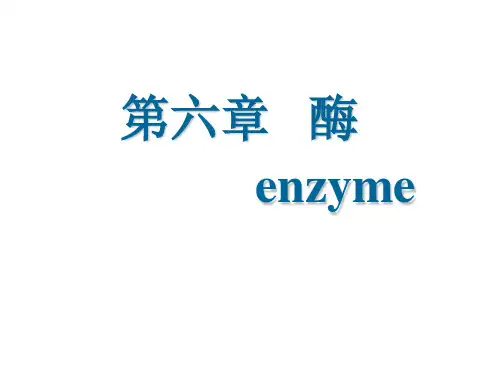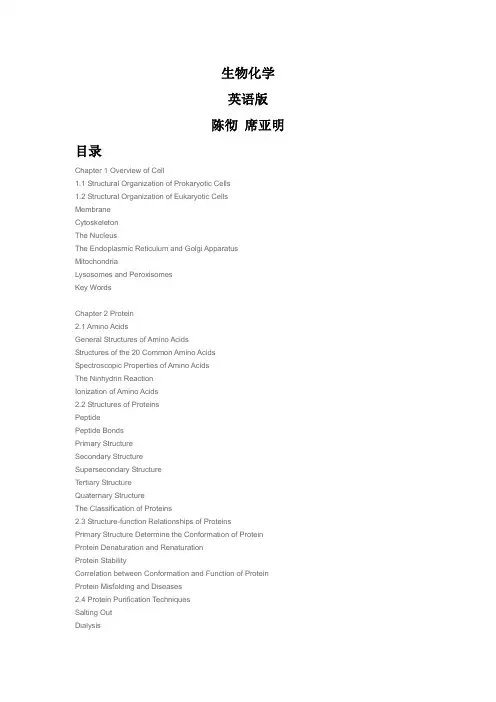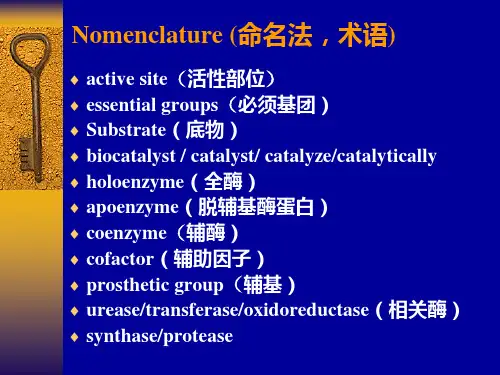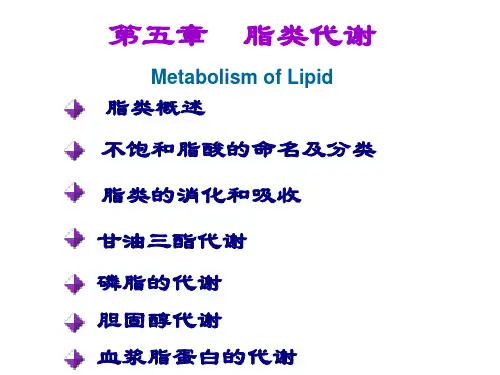生物化学英文课件:EnzymesSupplementoryInfoChapter5-2
《生物化学》教学课件-第六章 酶

最适温度:使V达到最大时的反应温度
四、 pH对反应速度的影响
• 影响酶、底物、辅助因子等的解离程度 • 体外实验选取适当缓冲液
最适pH——酶促反应速度达到最大时的溶液的pH
五、激活剂对反应速度的影响
激活剂——能使酶活性提高的物质 Mg2+-ATP对己糖激酶 Cl-对唾液淀粉酶
必需激活剂(无活性变为有活性 ) 非必需激活剂(酶活性提高)
六、抑制剂对反应速度的影响
抑制剂(inhibitor)—— 使酶活性降低而又不使酶变性的物质
抑制作用
不可逆抑制
丝氨酸酶抑制剂 巯基酶抑制剂 竞争性抑制作用
可逆性抑制
非竞争性抑制作用 反竞争性抑制作用
(一)不可逆抑制作用
• 概念:抑制剂与酶活性中心必需基团共价结合, 不能用透析、超滤等物理方法将其除去恢复酶 活性。
J.B.萨姆纳 James Batcheller Sumner 美国 (1887~1955) 1926年:脲酶结晶 1937年:过氧化氢酶结晶 1946年:获诺贝尔化学奖
生物催化剂
酶 核酶(具有催化作用的核酸)
教学内容
酶的分子组成与活性中心 酶促反应特点与机制 酶促反应动力学 酶的调节 酶的命名与分类 酶与医学的关系
酶的磷酸化与脱磷酸化
ATP
ADP
蛋白激酶 Thr Ser -OH Tyr
磷蛋白磷酸酶
酶蛋白
Thr Ser -O-PO3H2 Tyr
磷酸化的酶蛋白
Pi
H2O
3.酶促化学修饰调节的特点及生理意义
(1)具有 无活性 和 有活性 两种 (低活性) (高活性)
(2)活性互变由不同的酶所催化 (3)属快速调节方式 (4)有共价键的变化 (5)有放大效应
生物化学PowerPointPresentation

酶是生物催化剂(biological catalyst), 具有两方面的特性,既有与一般催化剂相 同的催化性质,又具有一般催化剂所没有 的生物大分子的特征。酶与一般催化剂一 样,只能催化热力学允许的化学反应,缩 短达到化学平衡的时间,而不改变平衡点。 酶作为催化剂在化学反应的前后没有质和 量的改变。微量的酶就能发挥较大的催化 作用。酶和一般催化剂的作用机理都是降 低反应的活化能(activation energy)。因为 酶是蛋白质,所以酶促反应又固有其特点。
• 当底物浓度很低([S]《 Km)时,V=Vmax [S]/ Km,反应速度与底物浓度成正比。当底物浓度很高 ([S] 》Km)时,V≌Vmax,反应速度达最大速度, 再增加底物浓度也不再影响反应速度。
PPT文档演模板
生物化学PowerPointPresentation
•Km是酶学研究中一个常数,有重要意义: •1.当反应速度为最大速度一半时,米氏方程式可以变换如下:
• 酶活性中心内的必需基团可分为两种:一 是结合基团,其作用是与底物相结合,使底物 与酶的一定构象形成复合物;另一是催化基团, 其作用是影响底物中某些化学键的稳定性,促 进底物转变成产物,有些必需基团同时具有这 两方面的功能。
PPT文档演模板
生物化学PowerPointPresentation
•二、酶原及酶原激活
生物化学PowerPointPresentati
on
PPT文档演模板
2020/11/30
生物化学PowerPointPresentation
•第五章 酶 化 学
•主要内容:
• 主要介绍酶的化学本质、结构和特性; 酶的作用动力学;酶的作用机理;酶的应 用;还介绍了别构酶、共价调节酶、同工 酶等的概念、性质、生物学意义。
生物化学英语版

生物化学英语版陈彻席亚明目录Chapter 1 Overview of Cell1.1 Structural Organization of Prokaryotic Cells1.2 Structural Organization of Eukaryotic CellsMembraneCytoskeletonThe NucleusThe Endoplasmic Reticulum and Golgi Apparatus MitochondriaLysosomes and PeroxisomesKey WordsChapter 2 Protein2.1 Amino AcidsGeneral Structures of Amino AcidsStructures of the 20 Common Amino AcidsSpectroscopic Properties of Amino AcidsThe Ninhydrin ReactionIonization of Amino Acids2.2 Structures of ProteinsPeptidePeptide BondsPrimary StructureSecondary StructureSupersecondary StructureTertiary StructureQuaternary StructureThe Classification of Proteins2.3 Structure-function Relationships of ProteinsPrimary Structure Determine the Conformation of Protein Protein Denaturation and RenaturationProtein StabilityCorrelation between Conformation and Function of Protein Protein Misfolding and Diseases2.4 Protein Purification TechniquesSalting OutDialysisGel Filtration ChromatographyIon Exchange ChromatographyAffinity ChromatographyElectrophoresisSDS Polyacrylamide Gel Electrophoresis (SDS-PAGE)Isoelectric FocusingTwo Dimensional ElectrophoresisUltracentrifugationKey WordsChapter 3 Enzymes3.1 The History of Enzymes3.2 Naming and Classification of EnzymesEC 1 OxidoreductasesEC 2 TransferasesEC 3 HydrolasesEC 4 LyasesEC 5 IsomerasesEC 6 Ligases3.3 Structural Components of EnzymesApoenzymes,Cofactors and HoloenzymesActive Center of EnzymesIsozymes3.4 The Properties of Enzymatic CatalysisEnzymes Greatly Accelerate the Rates of Chemical Reactions Specificity of EnzymesControllability of Enzyme Activity3.5 Mechanism of Enzymatic CatalysisTransition State and Activation EnergyLock and Key HypothesisInduced Fit HypothesisEnzyme-Substrate Interactions3.6 Enzyme KineticsSubstrate Concentration Affects the Rate of Reactions Michaelis-Menton KineticsThe Significance of KmMeasurement of Km and VmaxEnzyme Concentration Affects the Rate of Reactions Temperature Affects the Rate of ReactionspH Value Affects the Rate of ReactionsInhibition of Enzyme Catalyzed Reactions……Chapter 4 Coenzymes and VitaminsChapter 5 Nucleic AcidsChapter 6 DNA ReplicationChapter 7 RNA Synthesis-TranscriptionChapter 8 Protein Synthesis-TranslationChapter 9 Regulation of Gene ExpressionChapter 10 Carbohydrate MetabolismChapter 11 Electron Transport and Oxidative Phosphorylation Chapter 12 Lipid MetabolismChapter 13 Amino Acid MetabolismChapter 14 Nucleotides MetabolismChapter 15 Cell SignalingChapter 16 The Popular Techniques in Molecular Biology ReferenceIndex。
【精品】生物化学上册-第二章双语课件PPT课件

Haworth projections
CH2O H
H
O
H
OH
H
OH
OH OH O
H
H
H
CH2O H
H
H
OH
O
H
F lip p in g
OH H
CH2O H
H
OH
OH
H
OH
H
OH
OH
H
OH
H
-D -G lucose
-L -G lucose
8 D-forms
4 C* 24 = 16 isomers
8 L-forms
Rotation
Clockwise (顺时针) – dextrorotatory (右旋光, +) Counterclockwise (反时针) – levorotatory (左旋光, –)
Temperature
Concentration (浓度, g/ml)
RotatioBiblioteka (旋光度)t = []t c l
16
Aldoses (醛糖)
17
Ketoses (酮糖) 18
II. Monosaccharides
Two systems of specifying the absolute configurations (绝对构型的两种表达体系)
D/L – referring to the configuration of the molecule (对整个分子而言) R/S – referring to the configuration of a specific C* (对单个C*原子而言)
❖ Potential to form multiple hydrogen bonds with water or other molecules (形成氢键的能力)
生物化学 Chap 6 enzymes

active site(活性部位) essential groups(必须基团) Substrate(底物) biocatalyst / catalyst/ catalyze/catalytically holoenzyme(全酶) apoenzyme(脱辅基酶蛋白) coenzyme(辅酶) cofactor(辅助因子) prosthetic group(辅基) urease/transferase/oxidoreductase(相关酶) synthase/protease
e.g. trypsin E.C.3.4.21.4
―3‖ denotes that it is a hydrolase; (大类)
―4‖ that it is a protease that hydrolyze peptide bonds; (亚类)
“21‖ that it is a serine protease with a critical serine residue at the active site; (亚亚类) “4‖ that it was the fourth enzyme to be assigned to this class. (流水编号)
clas s 1 name Oxidoreductases 氧化还原酶 Transferases 转移酶 Hydrolases 水解酶 Lyases 裂合酶 Isomerases 异构酶 Ligases/ synthases 合成酶 Type of reaction catalyzed Transfer of electrons or hydrogen AH2+B A+BH2
生物化学课件 第五章 脂类代谢PPT幻灯片

廿碳五烯酸 (EPA)
20:5 5,8,11,14,17 3,6,9,12,15 ω-3 鱼油
廿二碳五烯酸 (DPA)
22:5
7,10,13,16,1 9
3,6,9,12,15
ω-3
鱼油, 脑
廿二碳六烯酸 (DHA)
22:6
4,7,10,13,16 3,6,9,12,15,
,19
18
ω-3
鱼油
第二节
O RCH2CH2C-OH
脂肪酸
=
=
脂酰CoA合成酶
+ CoA-SH
ATP AMP PPi
O
RCH2CH2C~SCoA 脂酰~SCoA
* 脂酰CoA合成酶(acyl-CoA synthetase)存 在于内质网及线粒体外膜上
2. 脂酰CoA 进入线粒体
关键酶
3. 脂酸的β氧化 O
==
RCH2CH2C~SCoA
第五章 脂类代谢
Metabolism of Lipid
脂类概述 不饱和脂酸的命名及分类
脂类的消化和吸收
甘油三酯代谢 磷脂的代谢 胆固醇代谢 血浆脂蛋白的代谢
1.定义 2.分类
脂类概述
脂肪和类脂总称为脂类(lipid)
脂肪 (fat): 三脂酰甘油 (triacylglycerols,TAG) 也称为甘油三酯 (triglyceride, TG)
脱氢
脂酰CoA
FAD
脱氢酶
β αO
FADH2
RCH=CHC~SCoA
脂酰CoA 反⊿2-烯酰CoA
加水
⊿2--烯脂酰CoA 水化酶
H2O
再脱氢 硫解
=
β αO RCHOHCH2C~SCoA
5 Enzyme
Enzyme activity:Enzyme catalytic power generally can be
Specific activity of enzyme: purity of enzyme, generally expressed as U/mg protein. Turnover number(Kcat):Measure of enzyme maximal
Projects/Titles for seminar
1. Research and applications of metalloenzymes
2. Progress in enzyme engineering
3. Artificial enzyme 4. Enzyme application
1. Enzyme generality
Chapter 5 Enzyme
1. Enzyme generality 2. Enzyme existing form
3. Mechanisms of enzyme action and
enzyme regulation 4. Enzyme kinetics 5. Enzyme engineering
(1) Oxidoreductases:EC1, involved in redox reactions, i.e., transfer of hydrogen or oxygen atoms between molecules. This class includes: dehydrogenases脱氢酶 (hydride transfer), oxidases (e- transfer to O2), oxygenase氧合酶 (oxygen atom transfer from O2), and peroxidases过氧化物酶 (e- transfer to peroxides) (2)Transferases:EC2, the transfer of an atom or group of atoms (like acyl-, alkyl- and glycosyl groups) between two molecules. The transferred groups are different from those transferred by the other classes of enzymes like Oxidoreductases, etc. (3)Hydrolases:EC3, catalyze hydrolytic reactions (and their reversals); this class includes esterases, glycosidases糖苷酶, proteases and lipases.
the seventh chapter enzyme chemistry 分子生物学课件
7.10 酶的制备和鉴定
固定化酶:
吸附法 偶联法
交联法
包埋法
点击回目录
点击回目录
二、同工酶:乳酸脱氢酶 三、多酶系:丙酮酸脱氢酶系 四、诱导酶:β-半乳糖苷酶
P286
点击回目录
7.8 个别酶 一、溶菌酶:糖苷酶 二、尿激酶:溶血栓的激酶 三、超氧化物歧化酶SOD:
清除体内氧自由基 见P288
点击回目录
7.9 酶在人类生活上的重要性
理论上、实践上、工业上、农业上、 医药上、以及石油工业上都有重要意义。
酶的催化机制(2) Koshland的诱导契合假说
认为酶表面并没有一种与底物互补的固定形状, 而只是由于底物的诱导才形成了互补形状。
酶的催化机制(3)
邻近效应与轨道定向学说
酶
酶的催化机制(4)
的 高
共价催化
催 化
酶的催化机制(5)
性
底物构象改变学说
酶的催化机制(6)
酸碱催化
-OH的亲核催化(胰蛋白酶)
的结晶,并得到了X线衍射图,证明了ES复合物的存在。
酶的作用特点
1、具有极高的催化效率 2、具有高度的底物专一性:
①绝对专一性: ②相对特异性: ③立体异构特异性: 3、酶催化反应的可调节性 4、酶不稳定,容易失去它的催化活性 5、酶的催化活性与辅酶、辅基和金属离子有关
点击回目录
7.4 酶的结构和功能
酶第 化七 学章
7.1 酶的概念、命名和分类
1. 酶(enzyme)的概念 酶是一类由活性细胞产生的具有催化活性
和高度专一性的特殊蛋白质。 更广义地说,酶是生物体系的催化剂,生
物细胞都产生自己所需的酶,生物体中的各 种生化反应,包括物质转化和能量转化,都 需要特殊的酶参加催化。
生物化学精品课程.
Enzymes
groups to double bonds. (e.g.?). Isomerases(异构酶): catalyzing reactions involving
intramolecular rearrangements.
Ligases(连接酶): catalyzing reactions joining together two molecules.
生物化学精品课程chapterenzymes生物化学精品课程enzymeswereamongfirstbiologicalmacromoleculesstudiedchemically11muchearlyhistoryenzymeresearch
Chapter 6
Enzymes
Enzymes
生物化学精品课程
Enzymes
生物化学精品课程
2. The most striking characteristics of enzymes are their immense catalytic power and high specificity.
2.2 Enzymes are highly specific both in the reaction catalyzed and in their choice of substrates (i.e., reactants). 2.2.1 An enzyme usually catalyzes a single chemical reaction or a set of closely related reactions (side reactions leading to the wasteful formation of by-products rarely occur). 2.2.2 Enzymes exhibit various degrees of specificity in accord with their physiological functions (what of the following?): Low specificity: some peptidases, esterases, and phosphatases. Intermediate specificity: hexokinase己糖激酶, alcohol dehydrogenases, trypsin. Absolute or near absolute specificity: Many enzymes belong to this group, and in extreme cases, stereochemical specificity is exhibited (i.e., enantiomers 对映异构体are diபைடு நூலகம்tinguished as substrates or products). 生物化学精品课程
U339食品生物化学(英文)Chapter 5 Functions and Structure o
/archive/index.php/t-854644.html
There are a couple of reasons for biological homochirality.
One, our galaxy has a chiral spin and a magnetic orientation, which causes cosmic dust particles to polarize starlight as circularly polarized in one direction only. This circularly polarized light degrades D enantiomers of amino acids more than L enantiomers, and this effect is clear when analyzing the amino acids found on comets 彗星 and meteors 流星. This explains why, at least in the milky way 银河系, L enantiomers are preferred.
The Levels of Protein Structure
Primary Structure Secondary Structure Tertiary Structure Quaternary Structure
The Sequence of Amino Acids in Proteins
Bovine pancreatic ribonuclease A contains 124 amino acid residues, none of which are tryptophan. Four intrachain disulfide bridges (S-S) form cross-links in this polypeptide between Cys26 and Cys84, Cys40 and Cys95, Cys58 and Cys110, and Cys65 and Cys72. These disulfides are depicted [dɪ'pɪkt] by yellow bars.
